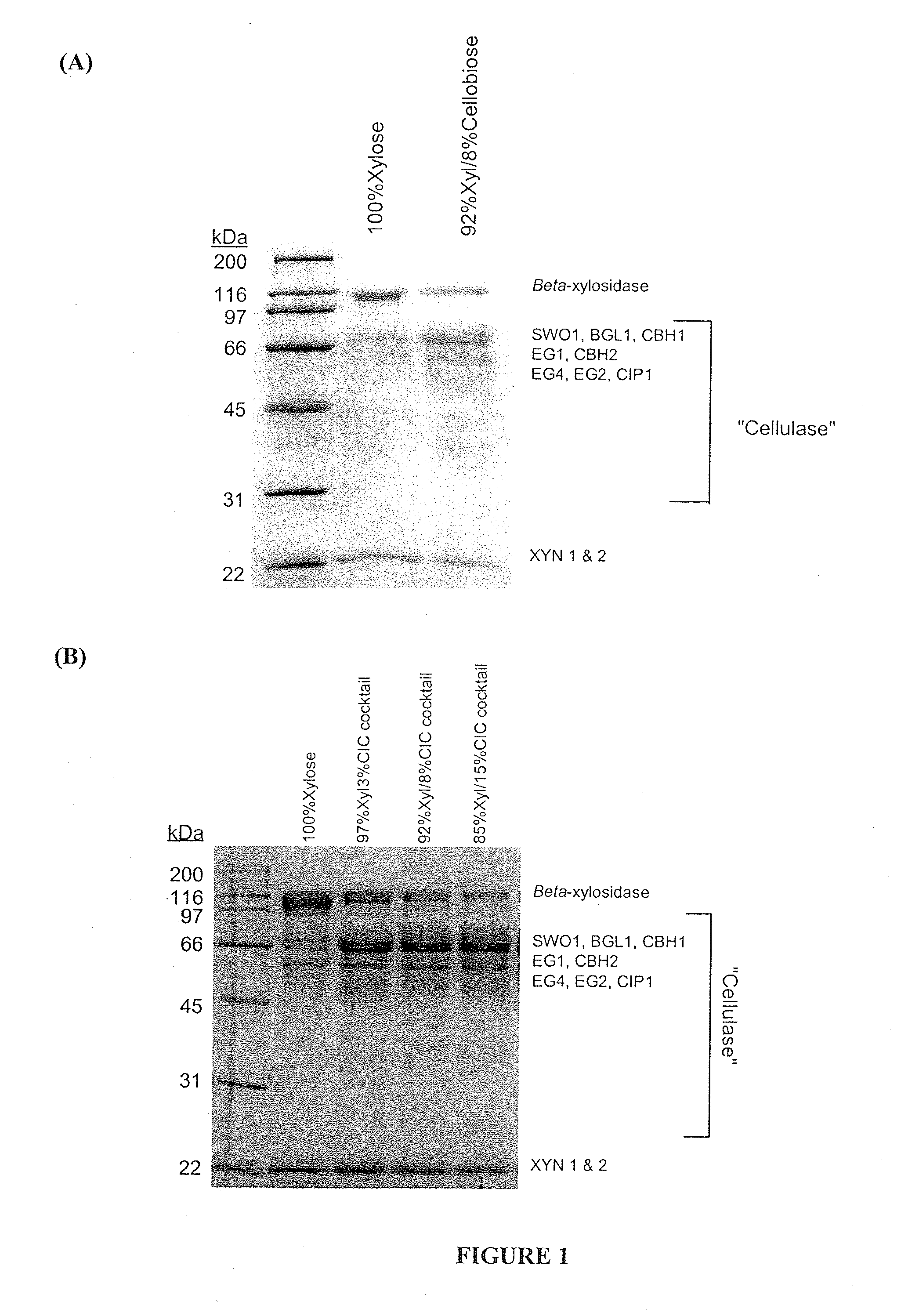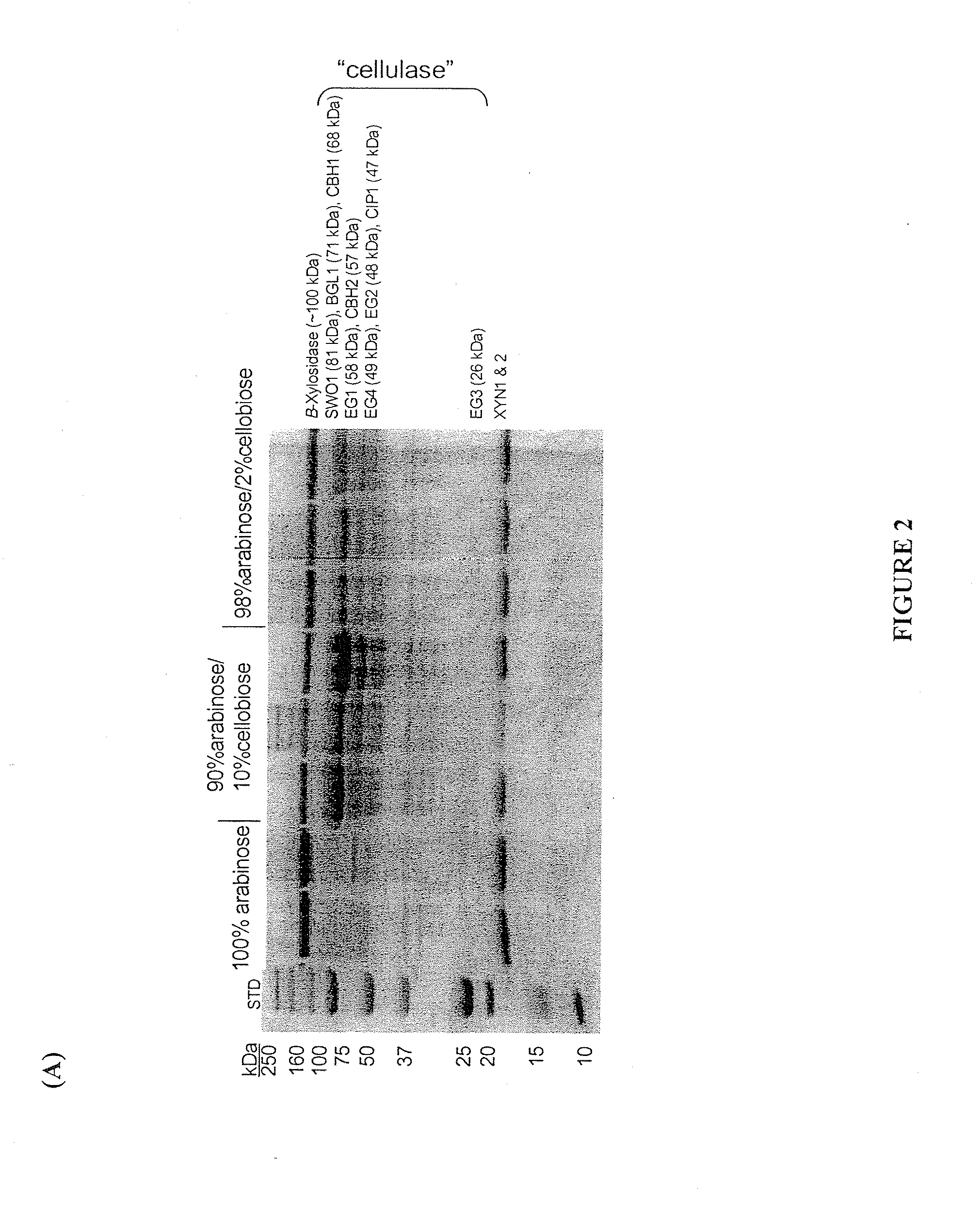Method for cellulase production
a cellulase and cellulase technology, applied in the direction of glycosylases, biochemical apparatus and processes, enzymes, etc., can solve the problem of inability to estimate the relative proportions of cellulase and hemicellulase in the secreted protein, the specific activity of the cellulase is reduced, and the effect of sawdust hydrolysates on the relative proportions of cellulase and hemicell
- Summary
- Abstract
- Description
- Claims
- Application Information
AI Technical Summary
Benefits of technology
Problems solved by technology
Method used
Image
Examples
example 1
Trichoderma reesei Strains
[0059]T. reesei strains RutC30 (ATCC #56765; Montenecourt, B. and Eveleigh, D. 1979. Adv. Chem. Ser. 181: 289-301) or P59G were used in the following examples. Strain P59G is a genetically modified strain that produces and secretes high levels of the beta-glucosidase encoded by T. reesei bgl1 as described in U.S. Pat. No. 6,015,703. The parent strain of P59G, strain BTR213, is a derivative of RutC30 produced by random mutagenesis and first selected for ability to produce larger clearing zones on minimal media agar containing 1% acid swollen cellulose and 4 g L−1 2-deoxyglucose and then selected for the ability to grow on lactose media containing 0.2 μg / ml carbendazim.
example 2
Fermentations Using Mixtures of HDC and CIC
[0060]Trichoderma spores from frozen (−80° C.) 15% glycerol stocks were inoculated onto standard 85 mm petri plates containing potato dextrose agar (PDA). These plates were incubated at 28° C. for 3-5 days to achieve a confluent growth of fresh green spores. To prepare the inoculum for fermentation testing, spores from a single PDA plate were transferred to 2 L, baffled Erlenmeyer flask containing 750 mL of liquid Berkley media (pH 5.5) supplemented with 5.1 g / L of corn steep liquor powder and 10 g / L glucose. Flasks were incubated at 28° C. for 3 days using an orbital agitator (Model G-52 New Brunswick Scientific Co.) running at 100 rpm.
Berkley Media for FlasksComponentg / L(NH4)2SO41.4KH2PO42.00MgSO4•7H2O0.31CaCl2•2H2O0.53Dry Corn Steep Liquor5.1Glucose10Trace elements*1 mL / L*Trace elements solution contains 5 g / L FeSO4•7H20; 1.6 g / L MnSO4•H20; 1.4 g / L ZnSO4•7H20.
2a. Fed-Batch Fermentations
[0061]The contents of an inoculum flask were transfe...
example 3
Specific Productivity
[0069]The fed-batch fermentation processes using both HDC and CIC exhibits 4-12 fold higher specific productivity than a corresponding processing using only HDC (Table 6, FIG. 4).
TABLE 6Specific productivity of 14L fed-batch cultures of T. reesei strainsused HDC with or without CIC.Carbon SourceqpbStrain(HDC / CIC)(mg protein / g cells / h)P59G100% xylose2 97% xylose / 3% CICa14 92% xylose / 8% CICa19 85% xylose / 15% CICa24100% arabinose3.5 90% arabinose / 10% cellobiose14RutC30100% xylose4 92% xylose / 8% cellobiose23aCIC: inducing cocktail comprising, as a function of total carbohydrate, 56% gentiobiose, 14% sophorose, 6% cellobiose, 10% trehalose, 6% maltotriose, 4% glucose and 14% other carbohydratesbFor strain P59G, reported values are the average results of three (xylose) or two (arabinose) replicate fermentations; for strain RutC30, the reported values are the results from single fermentations.
[0070]Continuous fermentation processes using CIC in combination with HDC mix...
PUM
| Property | Measurement | Unit |
|---|---|---|
| temperature | aaaaa | aaaaa |
| weight percent | aaaaa | aaaaa |
| weight percent | aaaaa | aaaaa |
Abstract
Description
Claims
Application Information
 Login to View More
Login to View More - R&D
- Intellectual Property
- Life Sciences
- Materials
- Tech Scout
- Unparalleled Data Quality
- Higher Quality Content
- 60% Fewer Hallucinations
Browse by: Latest US Patents, China's latest patents, Technical Efficacy Thesaurus, Application Domain, Technology Topic, Popular Technical Reports.
© 2025 PatSnap. All rights reserved.Legal|Privacy policy|Modern Slavery Act Transparency Statement|Sitemap|About US| Contact US: help@patsnap.com



